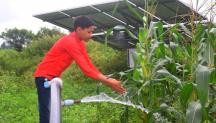

Renewable Power Generation Costs in 2021
Newsletter
Download the Executive Summary
The Executive Summary is also available in in Arabic (عربي), Chinese (中文), French (Français), German (Deutsch), Russian (Русский) and Spanish (español).
The global weighted average cost of newly commissioned solar photovoltaic (PV), onshore and offshore wind power projects fell in 2021. This was despite rising materials and equipment costs, given that there is a significant lag in the pass through to total installed costs.
The global weighted average levelised cost of electricity (LCOE) of new onshore wind projects added in 2021 fell by 15%, year‑on‑year, to USD 0.033/kWh, while that of new utility-scale solar PV fell by 13% year-on-year to USD 0.048/kWh and that of offshore wind declined 13% to USD 0.075/kWh. With only one concentrating solar power (CSP) plant commissioned in 2021, the LCOE rose 7% year-on-year to USD 0.114/kWh.
The period 2010 to 2021 has witnessed a seismic improvement in the competitiveness of renewables. The global weighted average LCOE of newly commissioned utility‑scale solar PV projects declined by 88% between 2010 and 2021, whilst that of onshore wind fell by 68%, CSP by 68% and offshore wind by 60%.
See the interactive infographic on how Competitiveness of Renewables Continued amid the Fossil Fuel Crisis.
The benefits from renewables in 2022 will be unprecedented, given the fossil fuel price crisis:
- The lifetime cost per kWh of new solar and wind capacity added in Europe in 2021 will average at least four to six times less than the marginal generating costs of fossil fuels in 2022.
- Globally, new renewable capacity added in 2021 could reduce electricity generation costs in 2022 by at least USD 55 billion.
- Between January and May 2022 in Europe, solar and wind generation, alone, avoided fossil fuel imports of at least USD 50 billion.
The data suggests that not all of the materials cost increases witnessed to date have been passed through into equipment prices. This suggests that price pressures in 2022 will be more pronounced than in 2021 and total installed costs are likely to rise this year in more markets.
IRENA’s cost analysis programme has been collecting and reporting the cost and performance data of renewable power generation technologies since 2012. The data and analysis is based on the the IRENA Renewable Cost Database that has data on around 21 000 renewable power generation projects from around the world.




